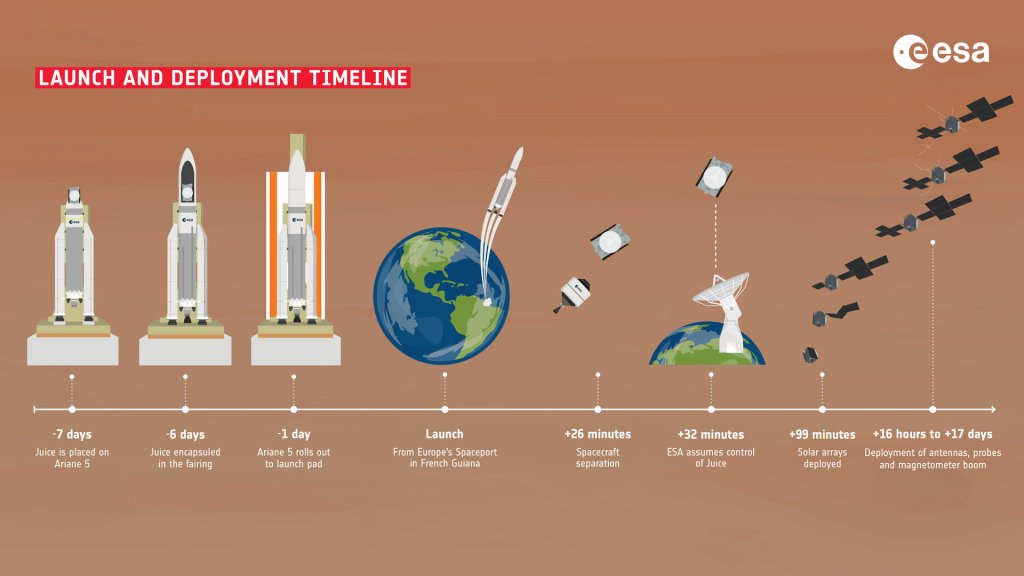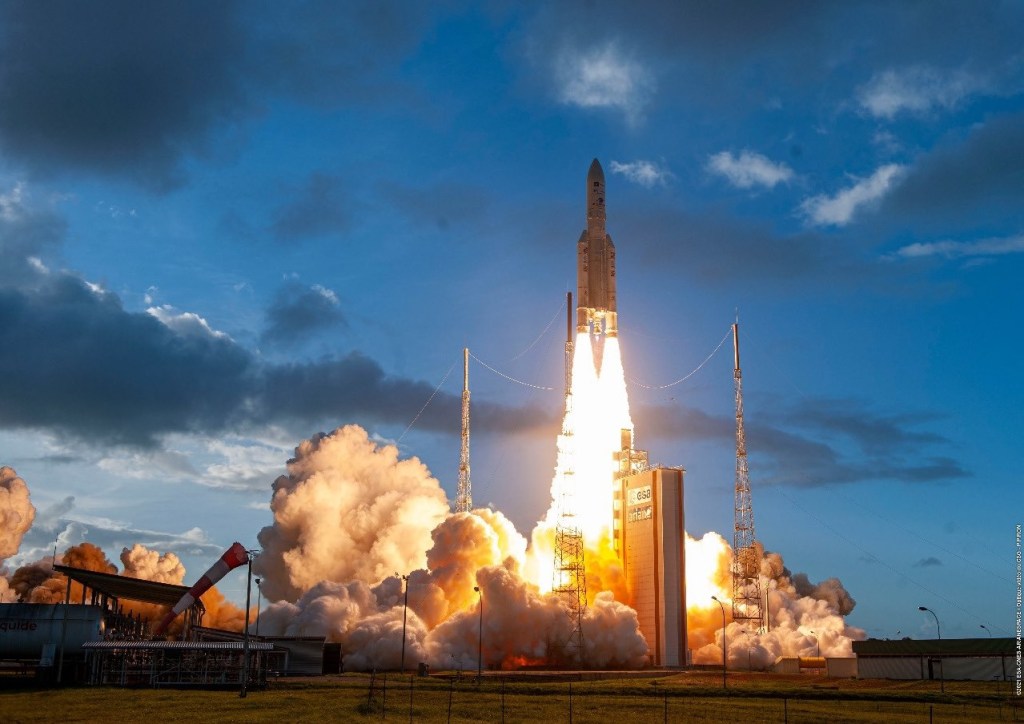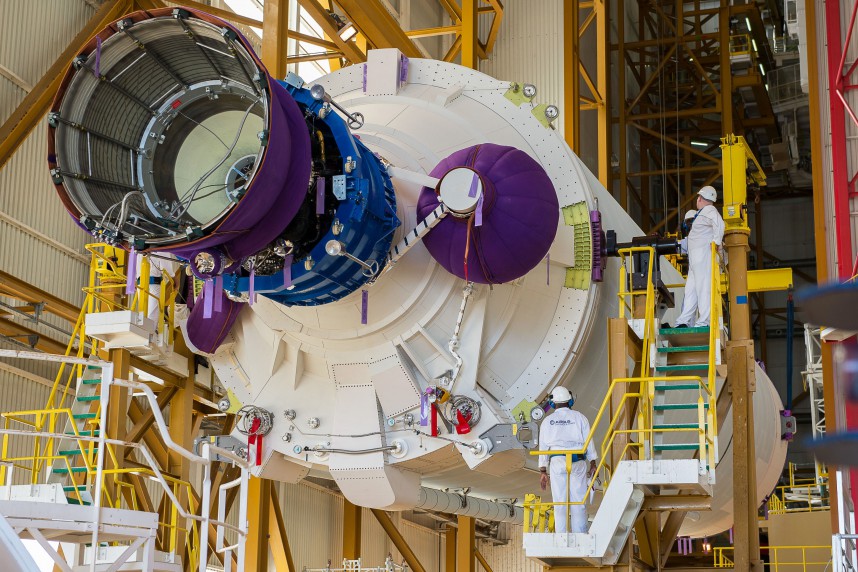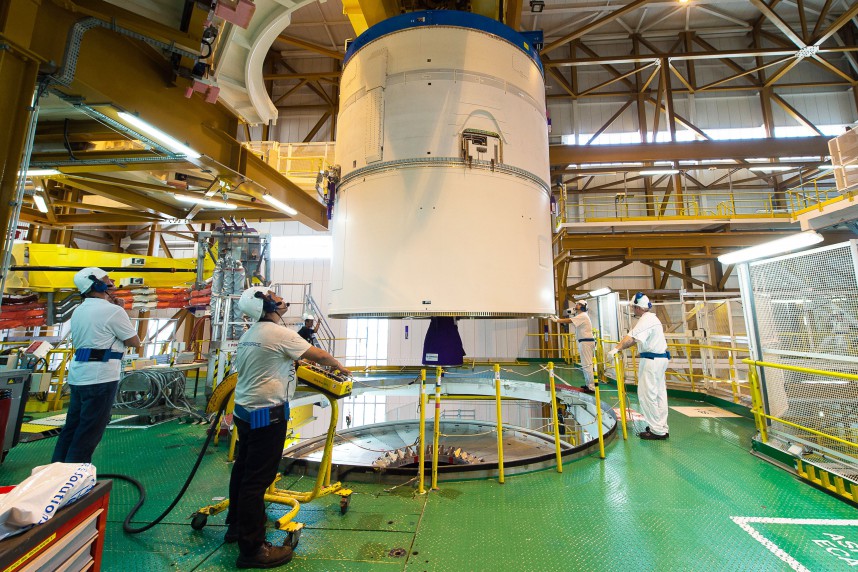Featured Image: Arianespace
Lift Off Time | April 14, 2023 – 12:14 UTC | 09:14 GYT |
|---|---|
Mission Name | JUICE (Jupiter Icy Moons Explorer) |
Launch Provider | Arianespace |
Customer | ESA |
Rocket | Ariane 5 ECA+ |
Launch Location | ELA-3, Guiana Space Centre, French Guiana |
Payload mass | 5300 kg |
Where is the satellite going? | Jupiter System |
Will they be attempting to recover the first stage? | No, this is not a capability of Arianespace |
Where will the first stage land? | It will crash into the Atlantic Ocean |
Will they be attempting to recover the fairings? | No, this is not a capability of Arianespace |
Are these fairings new? | Yes |
How’s the weather looking? | TBD |
This will be the: | – 295th Arianespace mission – 1st Arianespace mission of 2023 – 116th Ariane 5 mission – 1st Ariane 5 mission of 2023 – 53rd orbital launch attempt of 2023 |
Where to watch | Official livestream |
What’s All This Mean?
Arianespace is preparing to launch ESA’s Jupiter Icy Moons Explorer (JUICE) from Europe’s Spaceport in Kourou, French Guiana atop an Ariane 5 rocket. Once deployed, JUICE will begin an eight year journey to the Jupiter system, where it will study Jupiter and three of its ocean bearing moons.
This launch will be the last ESA mission to launch on the Ariane 5 from the ESA spaceport in Kourou, as the Ariane 6 will then take over ESA launches.
JUICE (JUpiter ICy moons Explorer)
JUICE is an interplanetary spacecraft that will travel to the Jupiter system to make detailed observations of Jupiter and three of its large moons – Ganymede, Callisto, and Europa – all of which feature large oceans. ESA has characterized the overarching theme of the mission as “the emergence of habitable worlds around gas giants.” Earth is the only planet in our solar system that we know for sure has supported life. Therefore this mission will seek to answer the question can it occur elsewhere in our solar system?
The three primary objectives of JUICE are:
- To study Jupiter’s icy moons.
- To explore the complex environment of Jupiter.
- To look at the overall Jupiter system as an archetype for what gas giants are like across the entire universe.
The spacecraft will carry ten scientific instruments, one experiment, and one radiation monitor. JUICE is a mission led by ESA, but it has several international collaborators. NASA, JAXA, and ISA have all provided hardware for the instruments aboard JUICE.
This mission will break several records, including being the first spacecraft to orbit a moon other than our own, as well as performing the first lunar-Earth gravity assist, which it will do to save fuel on its way to Jupiter.
Jupiter’s Icy Moons
Europa
Europa is the sixth-largest moon in the solar system. JUICE will make two flybys of Europa, with the closest approach being 400 km from the moon’s surface. When making its flybys, JUICE will primarily be looking for water and biosignatures and exploring the moon’s geology. Europa is thought to be one of the most promising places in our solar system for having a habitable environment, as scientists believe it is likely a saltwater ocean hidden below the icy surface of the moon, which could contain twice as much water as Earth’s oceans.

Ganymede
Ganymede will be JUICE’s primary target, with the spacecraft making 12 flybys of the moon. This is the largest of the moons of Jupiter and of the solar system. JUICE will approach the moon by up to 400 km during flybys, but while orbiting the moon it will aim to get as close as 200 km of the surface. The main goals of JUICE’s observations will be to observe the magnetic field of the moon (Ganymede is the only moon in our solar system to generate its own magnetic field), to search for hidden oceans, to look for ice, to study the interaction between the moon and Jupiter, as well as examine the potential habitability of the moon.

Callisto
Finally, JUICE will also study Callisto. Callisto is Jupiter’s second largest moon, and the third largest in our solar system. The surface of Callisto is the oldest and the most heavily cratered in our solar system, which means studying it can help us better understand what the environment would have been like in the early Jovian system. JUICE will make 21 flybys of the moon, with the closest approach being 200 km.

Science Instruments
JUICE will carry ten instruments aboard, nine of which are led by European operators, and one of which is led by NASA. There will also be one experiment aboard, the Planetary Radio Interferometer and Doppler Experiment (PRIDE), as well as a radiation monitor (RADEM)
There will be four remote sensing instruments:
- Optical camera system (JANUS). This instrument will look at the global, regional, and local features of the moons, and map the clouds of Jupiter.
- Visible and infrared imaging spectrometer (MAJIS). This instrument will study the clouds and atmosphere of Jupiter, as well as the ice and minerals on the surfaces of the moons.
- UV imaging spectrograph (UVS). NASA has contributed this instrument to the mission. This instrument will study the composition and dynamics of the moon’s exospheres.
- Sub-milliliter wave instrument (SWI). This instrument will study the temperature, composition, and dynamics of the atmosphere of Jupiter.
There will be three geophysical instruments:
- Radar sounder (RIME). NASA has contributed hardware for this instrument to the mission. This instrument is an ice penetrating radar which is able to study the internal structures of the moons up to a depth of 9 km.
- Laser altimeter (GALA). JAXA has contributed hardware for this instrument to the mission. This instrument will study the surfaces of the moons and the tidal deformation of Ganymede.
- Radio science experiment (3GM). ISA has contributed hardware for this instrument to the mission. This instrument will look at the gravitational field of Ganymede, the internal oceans of the three moons, and the atmosphere and ionosphere of Jupiter and the moons.
There will be three in situ instruments:
- Magnetometer (J-MAG). This instrument will use sensors to study the Jovian magnetic field and how it interacts with Ganymede, as well as studying the internal oceans of the moons.
- Particle environment package (PEP). NASA and JAXA have contributed hardware for this instrument to the mission. This instrument will study plasma in the Jupiter system.
- Radio and plasma wave instrument (RPWI). JAXA has contributed hardware for this instrument to the mission. This instrument will study radio emissions and plasma in Jupiter and the moons.

The Journey To Jupiter
It will take JUICE around eight years to arrive at Jupiter. In this time it will complete fly-bys of Venus and the Earth-Moon system. If all goes to plan, JUICE will reach Jupiter in July 2031. In the six months prior to entering Jupiter’s orbit, JUICE will begin conducting the research it was sent to do. Once it reaches the Jupiter system, JUICE will orbit Jupiter, and complete fly-bys of Europa, Ganymede and Callisto.

What Is The Ariane 5 ECA?
The Ariane 5 ECA is a European heavy-lift launch vehicle developed by Arianespace for the European Space Agency. Regarded as one of the most reliable launch vehicles in the world, the Ariane 5 has launched 109 times since 1996 with a 95.4% success rate.
The rocket flew 82 consecutive missions without failure before suffering a partial failure in January 2018. The Ariane 5 launches from the European Spaceport in French Guiana, a spaceport close to the equator, which allows the rocket to take advantage of the Earth’s greater rotation speed there and boost the launch performance.
The ECA version of the Ariane 5 is capable of launching two large satellites, one on top of the other, using an adapter known as the Système de Lancement Double Ariane (SYLDA). The adapter covers the lower satellite as it supports the higher satellite. When the time comes for satellite deployment, the top satellite is released first, the SYLDA is then jettisoned, and the bottom satellite is released last.

Boosters
Two P241 solid rocket boosters (SRBs) are attached to the sides of the rockets main stage. They are fueled with a mixture of ammonium perchlorate (AP) (68%), aluminium fuel (18%), and Hydroxyl-terminated polybutadiene (HTPB) (14%). Each booster provides about 7,080 kN (1,590,000 lbf) of thrust, burning for 130 seconds before crashing into the ocean. They are usually left to sink to the bottom of the ocean, but similarly to the Space Shuttles SRB, it is possible to recover them using parachutes. When this is done it is for post-flight analysis, and the boosters are not reusable.
Main Stage
The Ariane 5 has a cryogenic H173 main stage, called the EPC (Étage Principal Cryotechnique — Cryotechnic Main Stage), which burns for 540 seconds. It is comprised of a main tank, which is 30.5 m tall and has two compartments, one compartment for liquid hydrogen (LH2) and the other for liquid oxygen (LOx). A Vulcain 2 engine sits at the base and provides vacuum thrust of 1,390 kN (310,000 lbf).

Second Stage
The ECA has an upper stage called the ESC-A (Étage Supérieur Cryotechnique — Cryogenic Upper Stage), and uses an HM7B engine, which is fueled by liquid hydrogen (LH2) and liquid oxygen (LOx). The stage provides 67 kN (15,000 lbf) in vacuum, has an ISP of 446 seconds, and will burn for 945 seconds.







Shouldn’t the answer to: “Where will the first stage land?” be that it will crash into the Atlantic Ocean? Currently, the page states: “It will crash into the Pacific Ocean”
I Love the amount of information this article includes but agreed the first stage should crash in the Atlantic.
Why don’t you mention Airbus Space and Defense in the article when they have had the main contract of the satellite? Arianespace has only made the rocket but the prime contract of the satellite is Airbus’, and at the end, is the most important part of the mission… so i’m sorry but your information is not accurate.